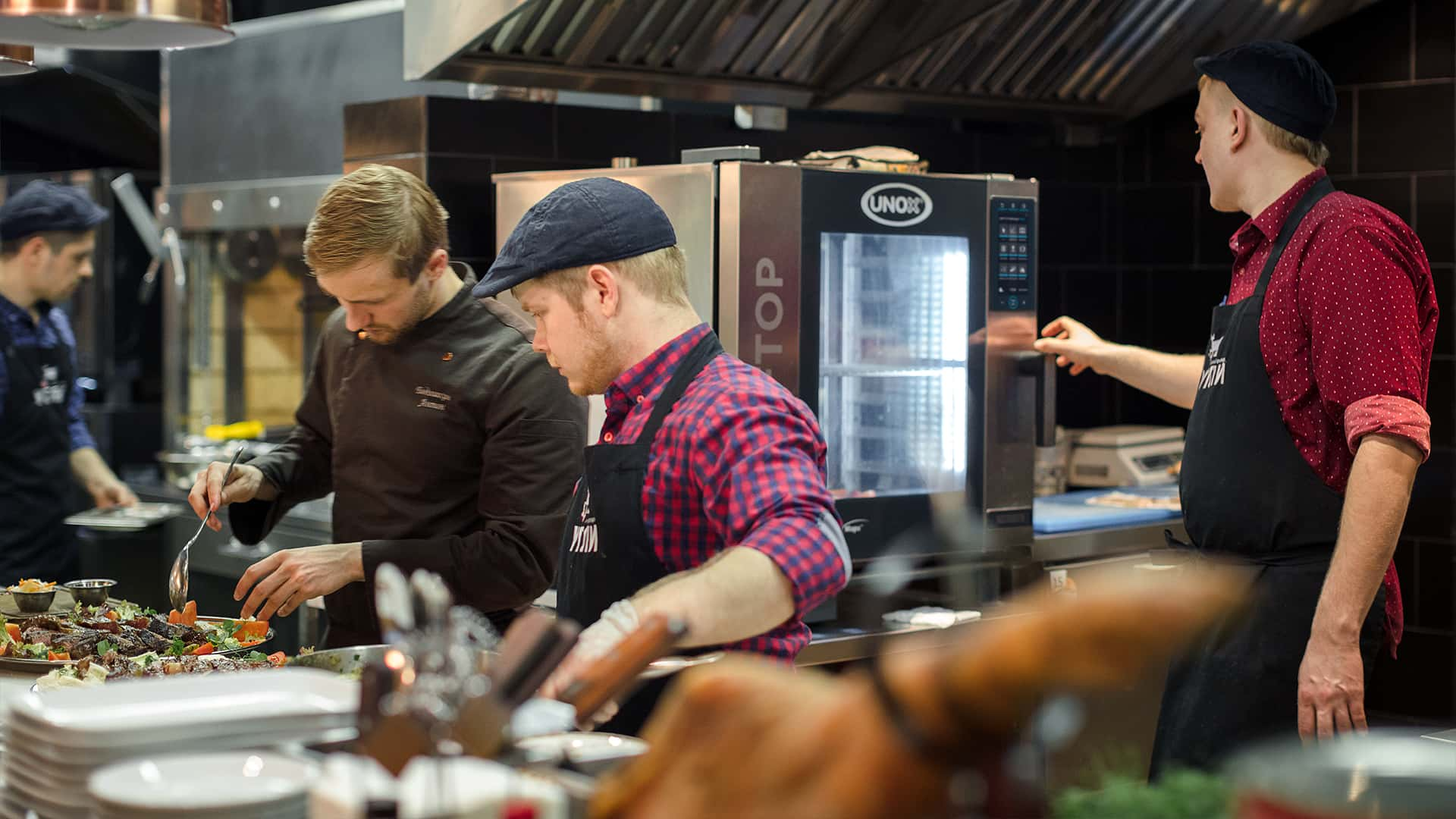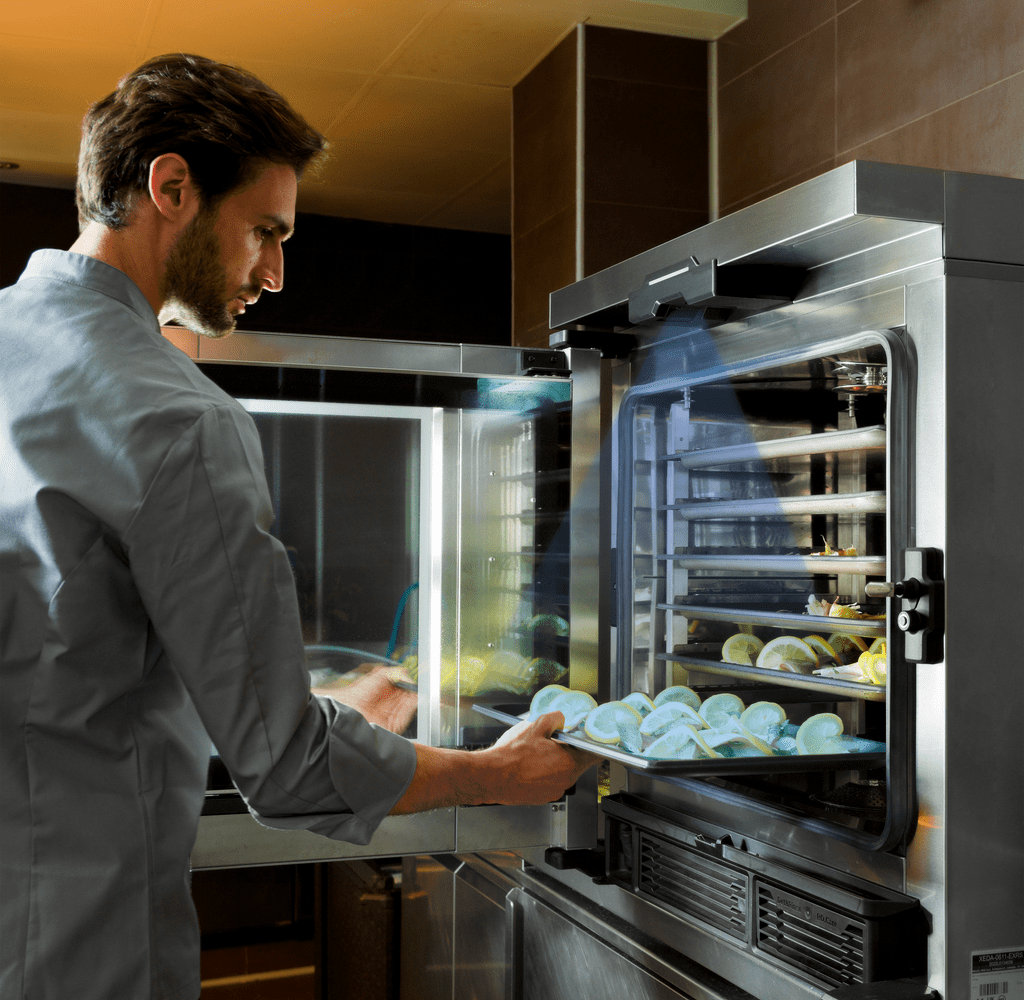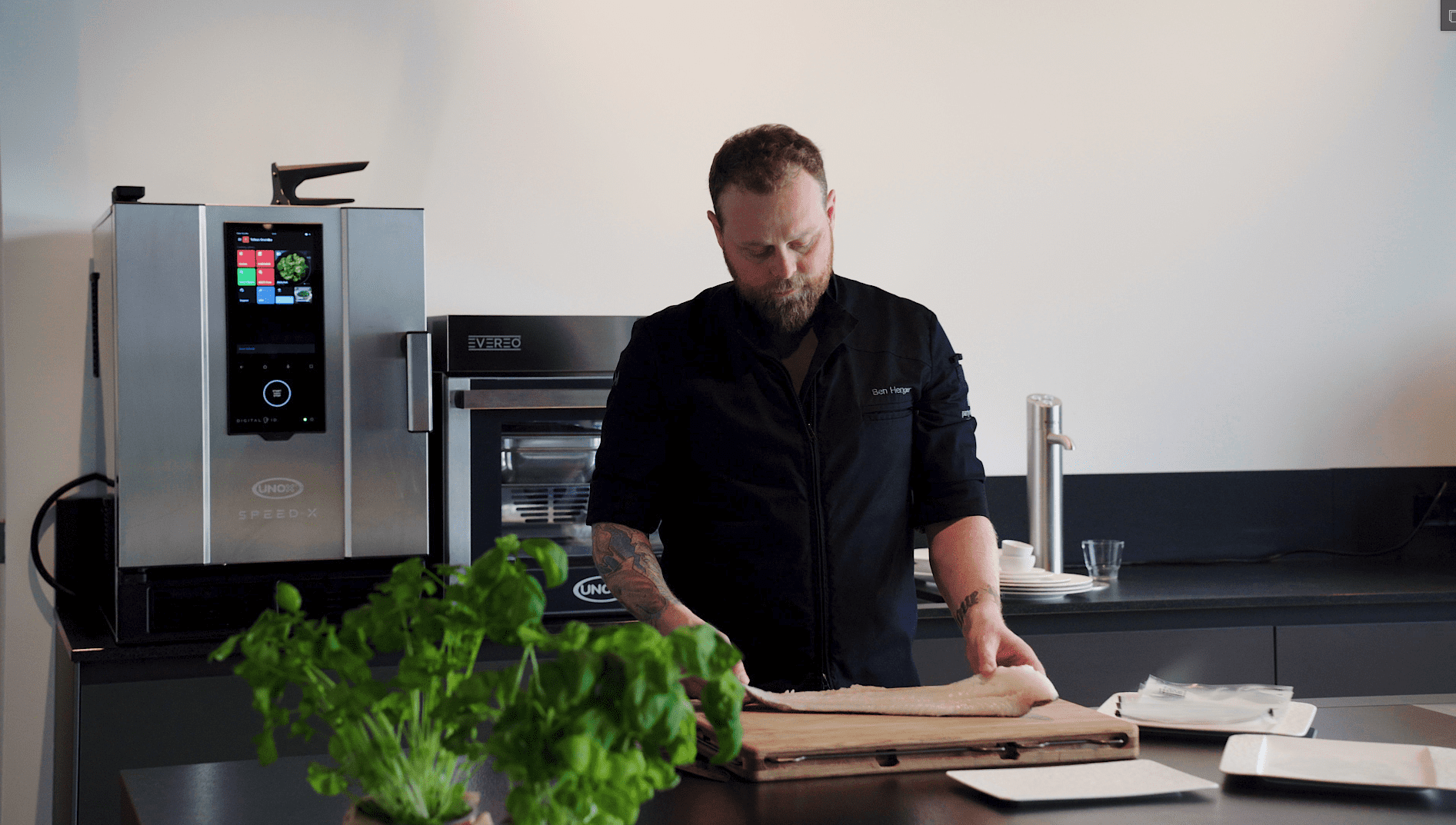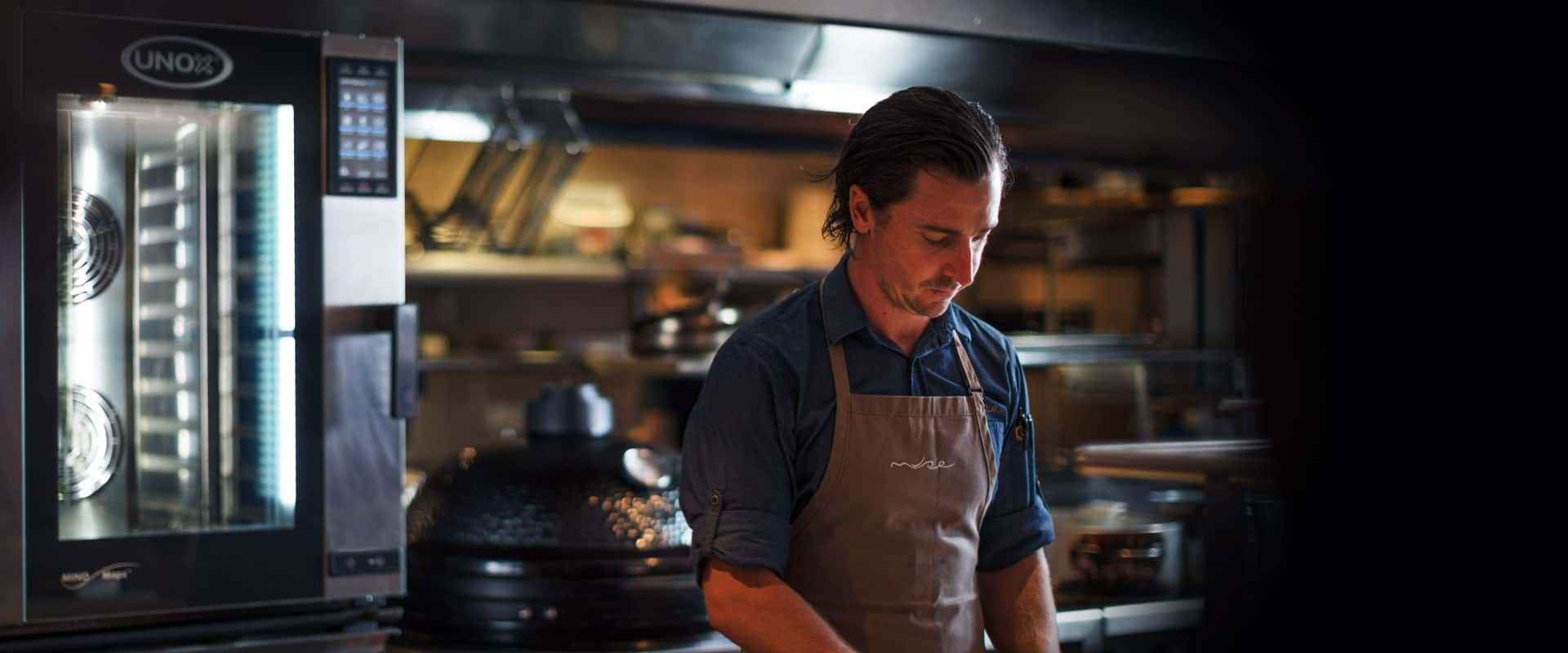What can you cook with a commercial combi oven?
The multifunctionality of professional combi ovens make them suitable for a wide array of cooking techniques. Whether you’re baking pastries, roasting meats, steaming vegetables, grilling fish, broiling garlic bread, reheating pre-cooked product, or cooking sous-vide, a combi oven can handle it all.
Combi ovens allow professional chefs to prepare multiple dishes simultaneously, without flavor transfer, and give maximum control over temperature, fan speeds, and humidity. The result of cooking with a commercial combi oven is a consistently perfect dish.
This unmatched versatility is what makes combi ovens a staple in commercial kitchens worldwide. Considering buying a commercial combi oven? We’ll cover key features to look for, total cost of ownership considerations, and even FAQs. Read on.
4 Key features & buying considerations for commercial combi ovens
Choosing the right commercial combi oven means evaluating key factors that affect performance, efficiency, and compliance. Here are four essential aspects to consider before you buy.
1. Combi oven size & tray capacity
When you begin your search for the right commercial combi oven, start with production volume. Always check both tray count and tray size to be sure the oven can meet peak-hour demand without bottlenecks, fitting into your professional kitchen’s layout and workflow.
Combi ovens, or steam ovens, are designed to accommodate Gastronorm (GN) trays, a standardized sizing system widely used in professional kitchens across the globe. Choosing the right GN tray format is essential when planning your workflow, storage needs, and equipment compatibility.
Large- and medium-sized restaurants usually need a 7- or 10-tray (GN 1/1 or GN 2/1) commercial combi oven. GN 1/1 tray is the industry standard size (20”×12”), which fits most combi ovens, blast chillers, and food transport trolleys. If your restaurant is higher volume, the GN 2/1 tray (25”x20”) may be a better fit.
Bakeries and pastry kitchens should align tray format and commercial combi oven size with your specific production flow. Many pastry programs prefer countertop or compact professional ovens compatible with GN 1/1 or GN 2/3 (13”x12”) trays especially when working with sheet pans and precise batch sizes.
For operations such as QSRs (quick serve restaurants), cafés, food trucks, ghost kitchens, or convenience stores, kitchen space is often limited and speed of service is key. In these cases, opting for a professional compact combi oven (e.g., 5-trays GN 1/1 or GN 2/3) allows you to maintain high output levels without overcrowding the workspace. These commercial ovens models are ideal for operations serving up to 50-100 meals per day.
In contrast, large-scale food production sites like hotels, casinos, hospitals, ghost kitchens, or commissary kitchens often require even higher capacities. A roll-in commercial combi oven that supports 16 or 20 trays enables chefs to cook multiple full loads simultaneously, drastically increasing efficiency. These units make the most of vertical space, reduce batch turnover times, and are suitable for producing hundreds of portions in a single cycle.
2. Combi oven power source & energy strategy
What power you have available will be the next step in narrowing down your search. Electric models offer precise temperature control and suit all-electric builds or venues without gas service.
Gas models can leverage existing utility infrastructure and, in some markets, carry lower energy-cost parity.
Look for low-idle energy consumption, rapid heat recovery, and, if sustainability is a priority, independent test data (e.g., ENERGY STAR®) that verifies savings.
3. Combi oven ventilation options
Local codes dictate whether you need a dedicated exhaust hood. If your situation makes ductwork impossible, like food trucks or historical buildings, look for ventless combi ovens with catalytic or condensate systems for capturing grease, moisture and other particulates.
For restaurants, bakeries, or cafés operating in highly regulated locations such as airports or governmental facilities, complying with strict emission control regulations is essential. In these environments, it's crucial to choose a combi oven with a safe and efficient venting or filtration system to prevent fines or operational shutdowns.
You’ll, of course, want to confirm approval from your jurisdictional authority before purchasing.
4. Combi oven core performance features to compare
Once you’ve narrowed down the specs for your new combi, here are some core features to keep in mind as you evaluate options.
· Active steam generation – Your new combi oven should produce saturated steam and precisely mix it with dry heat so you can switch from poaching to roasting without transferring flavor. Look for “active steam generation” features.
· Programmable touchscreen controls – A modern touchscreen will be easiest for onboarding new staff. The right controls will allow you to store multi-step recipes and lock critical parameters for junior staff. If you’re buying a future-proof combi, look for systems that add cloud connectivity for fleet-wide updates and HACCP (Hazard Analysis Critical Control Point) reporting.
· Self-cleaning and descaling cycles – Built-in cleaning programs cut labor, extend component life and maintain food safety standards. This feature is especially valuable for operations that use a combi oven for intensive food preparation, like roasting chickens or cooking mixed meats. But not all cleaning cycles are created equally, evaluate detergent cost, water usage, and total cycle time to see whether it fits your needs and workflow.
· Intelligent features for smarter efficiency – To control commercial combi oven consumption, choose ovens equipped with intelligent energy/water management systems and adaptive cooking. Extra sustainability features such as cleaning cycle sensing can help operators save significantly on resources and meet sustainability goals.
· Smart sensors and load detection – Staff often open and close the combi oven door multiple times throughout a cooking cycle. When you’re purchasing a commercial combi oven, note smart sensors for factors such as cavity humidity, temperature and food mass. These can auto-adjust fan speed and energy input, ensuring even coloration and doneness from the first tray to the last.
Commercial combi oven configurations & attributes
Commercial combi ovens are available in a variety of configurations to suit different kitchen layouts, operational needs and service volumes. From compact models for tight spaces to high-capacity roll-in units, here are the most common types and their key attributes.
· Compact / countertop combi ovens – Slim footprints designed for bars, taprooms and small prep areas
· Combi-microwave or “combi speed” ovens – Ideal for QSR, concessions and airport kiosks, comb-microwave hybrids add microwave energy to shave minutes off cook times while preserving browning and texture
· Roll-in combi ovens – Designed for high-volume kitchens and can accommodate trolley racks (16- or 20-tray capacity) and optimize vertical space for bulk cooking operations like hospitals, casinos, ghost kitchens, or catering operations
· Stacked combi oven configurations – Ideal for expanding cooking capacity without increasing footprint
· Ventless combi ovens – Integrated filtration eliminates the need for a Type I hood in many jurisdictions, opening doors for nontraditional sites
· Electric-only combi ovens – These units support decarbonization initiatives, all-electric buildings and venues without gas infrastructure
Remember: a single oven can combine multiple attributes, e.g., an electric, ventless, compact combi.
Popular applications for commercial combi ovens
Wondering where it makes sense to use a combi oven in a professional setting? Here are some common places you’ll find them.
· Restaurants & caterers – These operators often use a combi oven to batch-roast proteins in the morning, hold them juicy for service, then regenerate plates in minutes.
· Bakeries & pastry programs – Combi ovens allow bakers to proof, steam and bake without juggling separate proofer boxes and deck ovens. They boast a uniform lift, glossy crusts and a delicate crumb.
· Bars, cafés & coffee shops – In tight front-of-house layouts, a ventless countertop combi quickly reheats sandwiches, quiches and pastries without a full kitchen hood, helping keep ticket times short.
· QSR & high-volume kitchens – In these fast-paced environments, preset cooking programs help entry-level staff turn out consistent, delicious product at scale. Combis’ auto-standby modes can cut idle energy during slow periods.
Total cost of ownership & ROI for commercial combi ovens
Buying a combi oven is more than a sticker-price decision. To understand real value, factor in the three pillars of total cost of ownership (TCO):
1. Acquisition – Calculate equipment price, accessories, installation labor, and any required site upgrades for power, water or ventilation as your acquisition factor.
2. Operation – Consider energy and water use per cooking cycle, detergent for auto-cleaning, as well as routine maintenance and staff time saved by an equipment consolidation.
3. Longevity – What does the service life, warranty coverage and resale value look like?
Quick payback snapshot:
When comparing brands, ask manufacturers for third-party energy data (ENERGY STAR® or ASTM F2140 testing) and real-world case studies so you can plug reliable numbers into your ROI worksheet. In terms of energy savings, an ENERGY STAR® commercial electric combi oven such as Unox’s CHEFTOP MIND.Maps™ 10-tray model delivers significant performance advantages compared to other professional cooking equipment.
For example, when compared to an electric professional grill, an ENERGY STAR® electric combi oven can reduce energy consumption by up to 52.2%* based on an average of 50 kg of food cooked per day over one year.
Steam cooking? Professional combi ovens can save up to 42.7%* in energy compared to a steamer.
By air frying in a combi oven, you can cut energy use by up to 29.7%*.
Based on various projects implemented for major foodservice companies, replacing a traditional cooking setup consisting of 3 griddles, 3 fryers, 1 steamer, and 1 Unox combi oven with a more efficient configuration of 2 griddles, 2 fryers, and 3 Unox combi ovens allows you to maintain the same production capacity while greatly improving overall efficiency.
In kitchens producing 1,700 lbs. of food per day, this new configuration leads to a 15.6%* reduction in energy consumption and a significant 68.5% decrease in kitchen footprint over a 10-year period, demonstrating how modern combi ovens can consolidate equipment, optimize space, and lower operating costs without sacrificing output.
*Source: Unox ESG Report
Regulatory & certification checklist for commercial combi ovens
Before you sign a purchase order, confirm the model meets all relevant codes and standards in your jurisdiction:
· NSF/ANSI food-safety standard – Verifies cleanability of materials that contact food.
· UL or ETL safety listing – Ensures the electrical or gas system is commercially certified.
· ENERGY STAR® qualification – Validates efficiency and may unlock utility rebates.
· Local mechanical and exhaust codes – Determine whether a Type I or Type II hood, or an approved ventless system, is required.
· Water quality requirements – Consider whether you need a water filtration or softening system by confirming whether the warranty stipulates hardness, chloride or TDS (Total Dissolved Solids) limits.
Tip: Keep digital copies of certificates and hood-exemption letters. Inspectors often ask to see them during permitting and surprise visits.
Preventive maintenance & cleaning best practices for commercial combi ovens
A combi oven is a precision tool, and a little proactive care keeps it performing like new. Here’s what you need to know about maintenance before you buy.
Daily:
· Wipe the door gasket and glass with a damp cloth.
· Empty the drip tray and check for debris in the drain channel.
· Run auto-clean cycle (frequency is dictated by use and cooking type; for some, a cycle every 2-3 days may be sufficient).
Weekly:
· Run a rinse cycle to clear light grease.
· Inspect the door gasket for cracks or flattening and replace if compromised.
Monthly:
· Perform a descaling cycle with manufacturer-approved detergent (this may need to be performed more often depending on your water hardness).
· Change water-filter cartridges if necessary.
Quarterly:
· Have an authorized technician calibrate temperature probes and examine fan motors.
Annually:
· Perform planned maintenance services (some combi ovens come with additional after-sales services).
Ignoring combi oven maintenance has a price. Lime-scale buildup can increase energy consumption up to 25%, and a worn gasket can cost hundreds in lost steam and longer cook times. A disciplined maintenance schedule protects food quality and extends component life far beyond the warranty window.
Commercial combi oven FAQs
Can a commercial combi oven really replace my steamer and convection oven?
Yes, provided you choose a model with full-capacity steam generation and adequate fan control. Many operators retire two pieces of equipment the same day the combi arrives.
If I purchase a commercial combi oven, do I still need a salamander or grill for finishing?
Often not. Modern combi ovens hit 482°F / 250°C and can fan-sear or “TurboGrill” steaks and gratins. Evaluate your peak broiler volume to be sure.
Will a ventless combi pass my local code?
Most catalytic systems are UL-listed for grease vapor removal, but acceptance rests with the Authority Having Jurisdiction (AHJ). Submit the spec sheet before buying.
What water quality should I target for commercial combi ovens?
Manufacturers typically specify <60 ppm hardness, <30 ppm chlorides, and total dissolved solids (TDS) below 350 ppm. Install a softener or RO system if your municipal supply exceeds those limits.
How much training does staff need on a commercial combi oven?
With touchscreen programs, many kitchens have new hires cooking on spec within a single shift. Build a short SOP and keep laminated quick-start guides near the oven.
Can I integrate a commercial combi oven into my HACCP plan?
Look for models that log core-probe temperatures and cooking cycles automatically. Exportable CSV files make HACCP record-keeping virtually hands-free.
What makes Unox one of the best commercial combi oven brands?
Unox is a global name in commercial combi ovens. Here’s what sets it apart from competitors:
· Chef-focused innovation – Unox’s proprietary Digital.ID™ ecosystem delivers cloud connectivity, remote oven and washing monitoring and recipe sharing to keep operators in the know.
· Smart features – All Unox smart combi ovens are equipped with advanced technology such as MULTI.Time and ADAPTIVE.Cooking, which allow operators to cook up to 10 different items simultaneously. These features automatically adjust cooking parameters based on food load and door openings, ensuring consistent results every time.
· Built for commercial durability – Triple-glass doors limit heat loss, while 304/316 stainless steel construction resists corrosion and daily wear.
· Industry-leading ENERGY STAR® line-up – Unox offers more ENERGY STAR-certified commercial combi ovens than any other manufacturer, giving operators a wide choice of independently verified, high-efficiency models.
· Self-cleaning breakthroughs – Unox introduced the world’s first self-washing combi-speed oven, SPEED-X™, eliminating messy manual scrubbing and protecting HACCP compliance. This feature saves water, time and labor.
· Simple interfaces – Icon-driven controls and guided workflows help even new staff achieve consistent, high-quality results from day one.
Unox commercial combi oven line-up
Unox offers a full range of commercial combi ovens designed to meet the needs of every kitchen. From cutting-edge innovations to versatile all-rounders, here’s a look at the core models in the Unox line-up.
CHEFTOP-X™ – High-performance, next-generation combi
The newest generation of the CHEFTOP line raises the bar for speed, precision and sustainability.
· Size options – Choose 6- or 10-tray ovens in GN 1/1 or GN 2/1 to match everything from banquet product to a bistro line.
· OPTIC.Cooking food recognition – CHEFTOP-X™ has an optic sensor to “see” what you load then automatically launch the correct program, eliminating user error and saving time.
· Cooking feedbacks and automatic recipe optimization – CHEFTOP-X™ asks the chef for feedback after each cooking session to adapt and cook according to operator preference.
· HEY.Unox voice control – With voice activation, you can say, “Hey Unox, start pre-heat” handsfree so your chef never has to break workflow.
· SMART.Energy & triple-glass door – The CHEFTOP-X™ has AI that monitors idle time and drops the cavity into stand-by mode. AI energy controls + enhanced insulation = industry-leading kWh savings.
· Self-washing with water recirculation – CHEFTOP-X™’s cleaning cycles remove grease and lime while cutting detergent and water use.
· Built-in connectivity – The 16-inch Digital.ID™ touch display syncs with Data Driven Cooking for remote HACCP logs, recipe pushes, and real-time activity monitoring.
Explore CHEFTOP-X™ commercial combi ovens!
SPEED-X™ – the first self-washing combi-speed oven
SPEED-X™, launched in 2023, is the world’s first commercial oven to merge rapid-cook microwave tech with full combi capability and automatic washing. It boasts the following features:
· Dual personalities – Switch between combi (steam+convection up to 10 × GN 2/3 trays) and speed mode, which uses microwave boosters and a SPEED.Plate stone to finish menu items simultaneously
· 6-minute scallops, 90-second pizza – High-velocity airflow combined with focused microwaves slash ticket times without sacrificing color or texture.
· SENSE.Klean cycle – A two-minute patented wash ring blasts the cavity clean, so you can move from roasting a lamb to baking croissants without missing a beat.
· Built-in connectivity – The 16-inch Digital.ID™ touch display syncs with Data Driven Cooking for remote HACCP logs, recipe pushes, and real-time activity monitoring.
· Hyper-accelerated cooking – Dock the “hot fridge” EVEREO® beneath SPEED-X™ to create a hyper-accelerated cook-and-hold station that plates in seconds during peak volume.
Explore SPEED-X™ commercial combi-speed ovens!
CHEFTOP MIND.Maps™ PLUS – the ultimate commercial combi oven for enhanced versatility
The CHEFTOP MIND.Maps™ PLUS is a versatile “Swiss-army” combi line that grills, fries, smokes, bakes and steams with intuitive touch-and-draw controls. Options are available in COUNTERTOP, COMPACT and BIG (roll-in) versions.
Like other Unox oven models, this line includes MIND.Maps controls, multi-pulse fan speeds and ADAPTIVE.Cooking algorithms that self-tune for load size.
Other CHEFTOP MIND.Maps™ models:
· CHEFTOP MIND.Maps™ COUNTERTOP / COMPACT – Full GN 1/1 or 600 × 400 performance in a stack-friendly footprint
· CHEFTOP MIND.Maps™ BIG – Trolley-based, 20- to 40-tray capacity for commissaries, hospitals and banqueting
Explore CHEFTOP MIND.Maps™ PLUS combi ovens!
Your next step toward a smarter kitchen
A commercial combi oven can streamline production, elevate consistency, and cut operating costs, regardless of the brand you ultimately select. When chef-focused engineering, proven durability, and documented energy savings matter, Unox rises to the top.
Ready to put the power of a commercial combi oven to work for you?
Explore the full portfolio of Unox ovens to find the right commercial combi oven for you.



